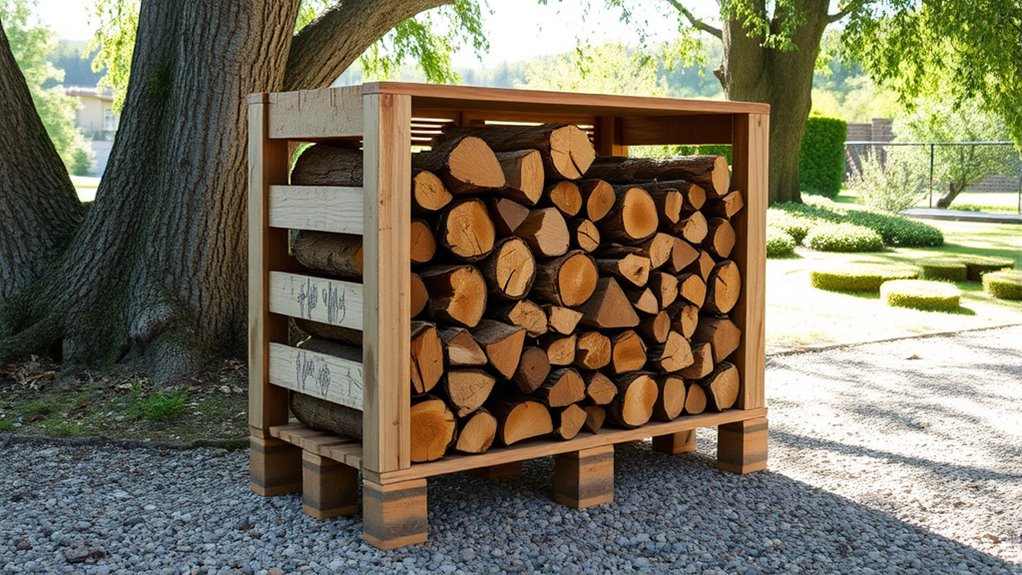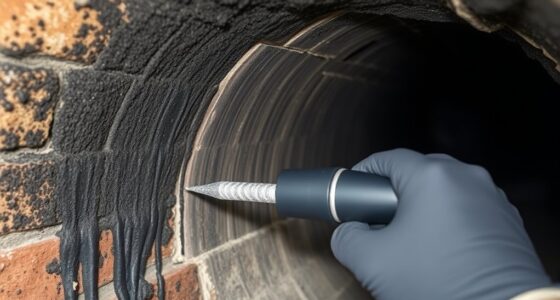To create a pallet-based firewood rack, start by choosing sturdy, weather-treated pallets, then carefully disassemble them, removing any damaged boards. Design your rack to fit your space, assemble the frame with screws or brackets, and secure a solid base on a level surface. Finish with weatherproofing, plan its ideal placement, and consider adding cross braces or a roof for extra stability. For steps that guarantee durability and easy access, keep exploring this helpful guide.
Key Takeaways
- Select durable, weather-treated pallets free of damage and pests to ensure a sturdy foundation for your firewood rack.
- Disassemble pallets carefully, clean and inspect boards for rot or splinters before assembly.
- Design the rack with sufficient depth (8-12 inches) for airflow, stability, and easy access to firewood.
- Assemble the frame using screws, brackets, and supports on a level surface for durability and stability.
- Finish the rack with weatherproof sealant, proper placement, and regular maintenance to extend longevity outdoors.
Gathering Materials and Tools
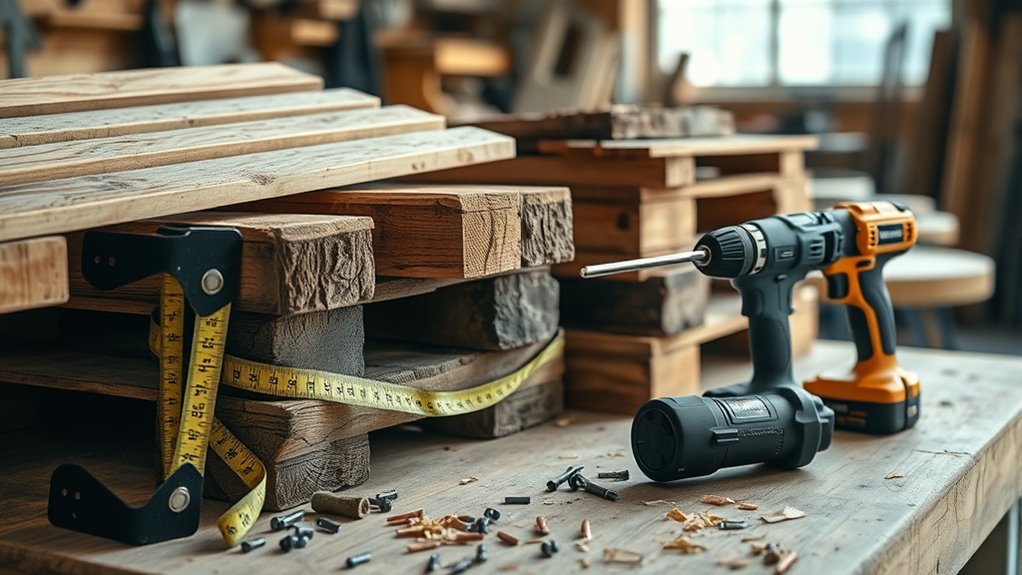
Before you start building your pallet firewood rack, you need to gather all the necessary materials and tools. First, pick up sturdy pallets, preferably weathered and free of rot or pests. You’ll also need basic supplies like a measuring tape, a pencil for marking, a saw (either hand or power), and a drill with appropriate bits. Consider getting screws or nails to assemble the rack, along with a level to ensure it’s even. Safety gear such as gloves and goggles are essential to protect yourself during construction. If you want a more polished look, paint or stain can be useful. Having all these materials ready before you begin will make the building process smoother and more efficient. Additionally, choosing pallets made from reclaimed wood can promote sustainability and durability for your project.
Preparing and Disassembling Pallets

Start by inspecting each pallet and selecting those in good condition, free from rot, pests, or broken boards. Once you’ve chosen suitable pallets, carefully disassemble them. Use a crowbar or pry bar to loosen nails or staples holding the boards together. Work slowly to avoid damaging the wood or splintering pieces. If nails are stubborn, apply a bit of lubricant or use a hammer to gently tap them free. Keep the boards organized as you remove them, so you know what you’re working with later. Disassembling might take some patience, but taking your time prevents accidents and ensures the wood stays intact. After disassembly, clean off dirt, debris, or old paint from the boards, preparing them for your firewood rack project. Proper wood preparation enhances the longevity and safety of your finished rack, especially since water parks often feature durable, weather-resistant structures that can inspire outdoor projects. Additionally, consider inspecting the wood for any signs of damage or rot, which is crucial for maintaining the integrity of your finished rack. Regular inspection and proper treatment can help prevent future skin damage, and applying protective finishes can also improve cognitive function by reducing exposure to harmful elements.
Designing Your Firewood Rack
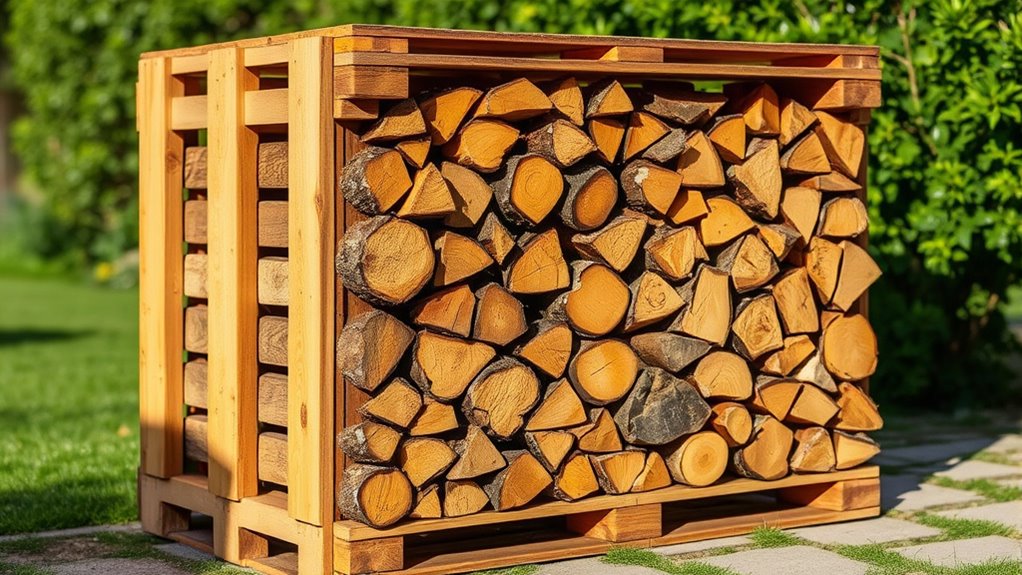
When designing your firewood rack, start by selecting the right pallet that can support your wood load and complement your space. Consider the ideal dimensions to keep your firewood organized and easily accessible, while ensuring the structure remains stable. Pay attention to structural stability tips to make sure your rack stays secure and durable over time.
Choosing the Right Palette
Choosing the right palette for your firewood rack is vital to guarantee it fits your space, style, and functional needs. Start by considering the type of wood and paint or stain that best suits your environment. If your space is outdoors, opt for weather-resistant finishes to protect against moisture and pests. For a rustic look, natural or distressed wood palettes work well, while sleek paint can give a modern vibe. Think about the color scheme of your surroundings—neutral tones blend seamlessly, while bold colors make a statement. Also, consider the palette’s durability; some woods and finishes stand up better to outdoor elements. Incorporating toilet cleaner effectiveness can further enhance the longevity of your project by preventing mold and mildew buildup on wooden surfaces. Incorporating vertical storage solutions can further enhance the rustic charm and longevity of your firewood rack. Selecting the right palette ensures your firewood rack is both functional and visually appealing, complementing your outdoor or indoor space effortlessly.
Optimal Rack Dimensions
Designing your firewood rack with ideal dimensions guarantees it functions efficiently and fits comfortably in your space. Start by measuring your firewood volume to determine the length, width, and height needed. A typical rack should be about 4 feet long, 2 feet wide, and 4 feet high, providing enough space for seasoned wood while maintaining stability. Ensure each compartment is around 8 to 12 inches deep to allow proper airflow and easy access. Consider your available space—if small, opt for a narrower or shorter design. Leave some extra room for easy loading and unloading. Remember, a well-sized rack prevents overloading, reduces stress on the structure, and keeps your firewood organized and accessible. Proper color accuracy in your design can help you identify the best placement and materials for visibility and durability. Adjust dimensions based on your specific storage needs and space limitations.
Structural Stability Tips
Ensuring your firewood rack is structurally stable is essential for safe and long-lasting storage. To achieve this, use sturdy pallets with solid slats and avoid damaged or weak wood. Reinforce joints with metal brackets or screws rather than nails alone, as they provide better hold. Make sure the base is wide and level to prevent tipping, and consider adding diagonal supports or braces for extra stability. Keep the rack low enough to prevent toppling if it’s heavily loaded, and distribute weight evenly across the structure. Securing the rack to a wall or anchoring it to the ground adds extra safety, especially in windy areas. Regularly check for loose parts or signs of wear, and replace or reinforce as needed to maintain stability over time. Additionally, choosing sturdy materials and ensuring proper design can help prevent accidents and prolong the life of your firewood rack. Incorporating structural reinforcement techniques can further enhance the durability and safety of your setup, drawing on principles from sound healing science to promote overall stability and well-being. Proper load distribution techniques help ensure the longevity and safety of your storage system, especially when considering environmental factors like weather exposure.
Assembling the Frame and Base

Start by choosing pallets that are sturdy and the right size for your rack. Next, assemble the frame structure, ensuring all connections are secure and level. To enhance the stability of your rack, consider adding cross braces, which can help prevent wobbling or collapsing under weight. Additionally, proper structural integrity is essential to ensure safety and longevity of your DIY firewood rack. Incorporating quality materials can further support long-term durability and overall safety. Finally, attach the base firmly to provide a stable foundation for your firewood.
Selecting Appropriate Pallets
Choosing the right pallets is essential for building a sturdy firewood rack. Look for pallets made from solid, untreated wood to guarantee durability and safety. Avoid pallets with visible damage, such as broken slats or excessive warping, as they won’t support weight well. Opt for pallets that are uniform in size and shape, making assembly easier and more stable. Check for signs of mold, rot, or chemical treatments—these can be harmful or weaken the structure. If possible, select pallets with minimal nails or staples, or remove them before use. Using high-quality, sturdy pallets will ensure your firewood rack holds up over time and withstands outdoor conditions. Properly chosen pallets set a strong foundation for your DIY project.
Building the Frame Structure
To build a sturdy frame for your firewood rack, begin by assembling the base using your selected pallets. Place two pallets parallel on a flat surface, ensuring they are aligned properly. Connect them with sturdy wooden or metal brackets at each corner for stability. Next, attach vertical support posts to the corners of the base, using screws and a drill for a secure fit. These posts will form the frame’s outline, so make sure they are level and plumb. Once the vertical supports are in place, connect them with horizontal beams along the top, creating the frame’s perimeter. Reinforce all joints with additional screws or brackets. This foundation provides the structure necessary to hold your firewood safely and securely.
Securing the Base Properly
Ensuring your base is properly secured is essential for the stability of your firewood rack. Start by placing the pallets on a flat surface, making sure they are level. Use heavy-duty brackets or metal L-brackets to connect the pallets at the corners, preventing shifting over time. Reinforce the joints with screws or bolts for added strength. If you’re on uneven ground, consider leveling the surface or adding a sturdy platform underneath. Check that the base is square and stable before loading firewood. Securing the base correctly guarantees your rack won’t wobble or tip when filled, keeping your firewood safe and accessible. Taking these steps now will save you trouble later and give your DIY firewood rack a solid foundation.
Finishing Touches and Placement Tips

Once you’ve built your pallet firewood rack, paying attention to finishing touches and placement can make a big difference in its durability and functionality. Sand any rough edges to prevent splinters and consider applying a weatherproof sealant to protect the wood from moisture. Adding cross braces or a simple roof can improve stability and keep your firewood dry. When placing your rack, choose a level, well-drained spot away from direct soil contact to prevent rot. Position it in a shaded area if possible to reduce weathering. Leave enough space around the rack for easy loading and unloading. Ensure it’s stable and secure, especially in windy conditions. Proper placement and finishing will extend your rack’s lifespan and keep your firewood organized and accessible.
Maintaining Your Firewood Rack for Longevity
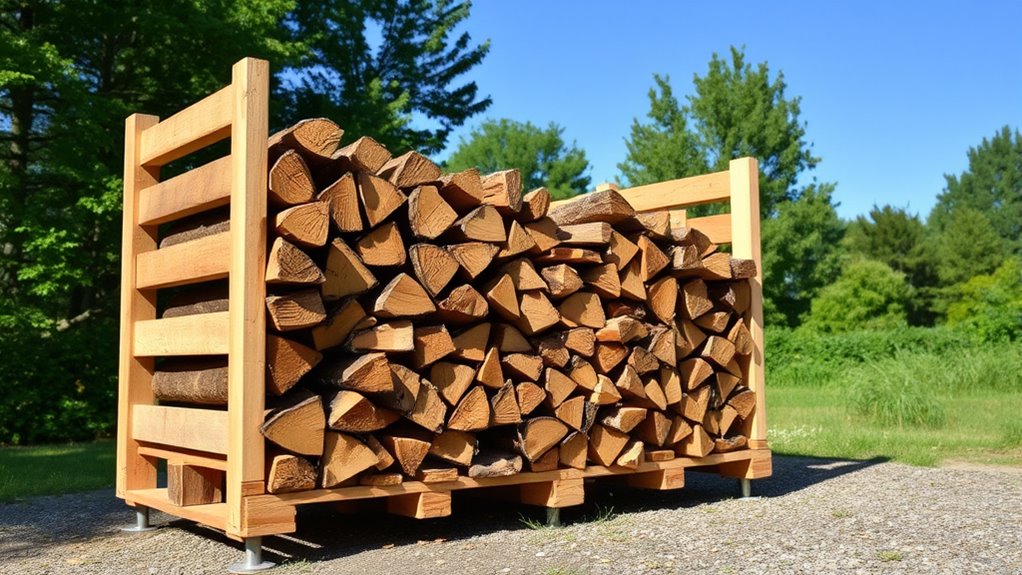
Regular maintenance is key to keeping your firewood rack in good shape and extending its lifespan. Inspect your rack regularly for signs of wear, such as rust, loose nails, or splintered wood. Clean off any dirt, sap, or debris to prevent decay. If you notice rust on metal parts, sand it down and apply a protective coat of paint or sealant. Tighten loose screws or nails to ensure stability. During off-season months, consider covering your rack with a waterproof tarp or relocating it to a sheltered spot. Treat the wood with a weather-resistant sealant annually to prevent moisture damage. Proper upkeep not only prolongs your rack’s life but also keeps your firewood safely stored and easy to access whenever you need it.
Frequently Asked Questions
What Are the Best Types of Wood for Building a Firewood Rack?
When choosing wood for your firewood rack, you want something sturdy and weather-resistant. Hardwoods like oak, maple, and hickory are excellent because they’re durable and can withstand outdoor conditions. Treated lumber or cedar also work well, as they resist rot and pests. Avoid softwoods like pine, which may decay faster. Selecting the right wood guarantees your rack stays strong and lasts through seasons of wood storage.
How Do I Ensure My Rack Is Weather-Resistant?
You want your rack to stand up to weather, and luckily, simple steps make it possible. First, choose treated or rot-resistant wood, then seal all surfaces with outdoor-grade sealant or paint. Add a roof or cover to shield against rain and snow, and elevate the rack slightly off the ground to prevent moisture absorption. These small measures keep your firewood dry and your rack durable through all seasons.
Can I Customize the Size to Fit My Space?
Absolutely, you can customize the size to fit your space. Measure the area where you want the rack, then adjust the pallet dimensions accordingly. Cut or assemble pallets to match your ideal width, height, and depth. Just guarantee the structure remains sturdy and stable. Using your measurements, you can create a firewood rack that perfectly fits your designated spot, making storage both practical and seamless.
What Safety Precautions Should I Consider During Assembly?
Imagine building a sturdy haven for your firewood where safety is your foundation. During assembly, you should wear gloves and eye protection to prevent injuries. Make certain all nails or screws are securely fastened to avoid collapse. Work on a stable, level surface, and keep tools organized to prevent accidents. Double-check measurements before drilling, and don’t rush—your safety is the key to a successful, worry-free project.
How Often Should I Clean or Treat the Wood?
You should clean and treat your firewood rack regularly to keep it in good shape. Clean the wood at least once a year with a brush or pressure washer to remove dirt and debris. Apply a weatherproof sealant or wood preservative every couple of years to safeguard against moisture, rot, and pests. Regular maintenance ensures your rack stays sturdy and safe, prolonging its lifespan and keeping your firewood dry and ready to burn.
Conclusion
Now that your pallet-based firewood rack is built, it’s like giving your firewood a cozy home to settle into. With a little care and regular maintenance, your rack will stand tall like a trusty guardian, keeping your wood organized and dry for seasons to come. Think of it as planting a sturdy tree—you’ll enjoy the fruits of your labor every time you light a fire, knowing your DIY creation is built to last.
